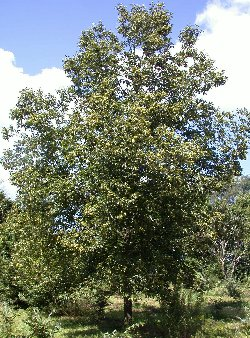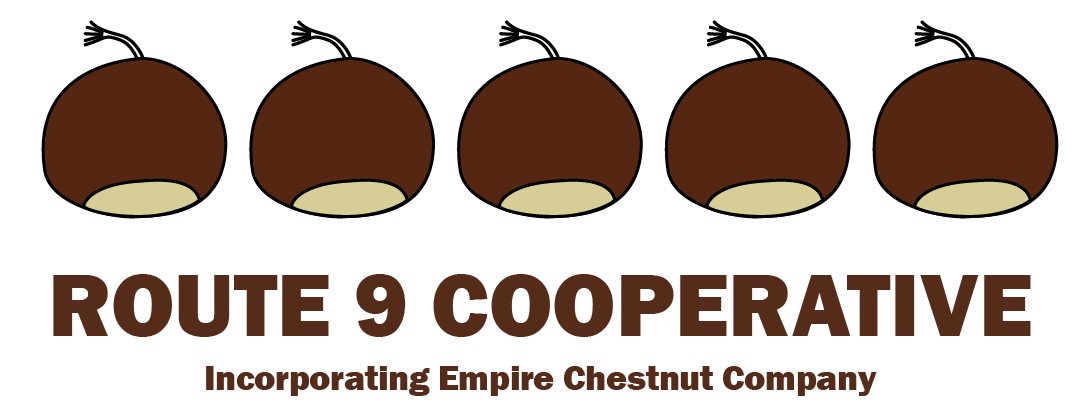Your cart is currently empty!
What We Offer
We sell chestnut seed and seedlings of the following species: Chinese, Japanese, American, and Allegheny chinkapin. We also sell hybrids selected specifically for wildlife, timber, and nut production. Seed is sold only in the fall. Seedlings are sold as bare-root stock, shipped from December through May, or as container stock (potted trees), that must be picked up at our nursery from September through November. Find prices and availability at our webstore.
Chinese (Castanea mollissima). Open-pollinated seed collected from superior mother trees, selected for nut production characteristics including large nut size, good kernel qualities, consistent yields, blight resistance, cold hardiness. Seed is generally sold as a mixture to ensure genetic diversity; see “Empire Elite Mix” described below. If you want seeds from one or more particular mother trees, you can specify that on the order form, selecting from the current list on the order page. Likewise, we offer seedlings from both mixed populations, and from specific mothers, that you can choose in lots of 10, from the list on the order page. Note that not all kinds of seeds are available as trees and vice versa. Chinese seedlings are available as 1-yr bare-root (12-24 in. tall), 1-yr bare-root (>24 in. tall), and 2, or 3-yr-old container grown trees. Below are brief descriptions of the kinds of seed and seedlings that we have available.
Empire Elite Mix – This is my default for small orders when no mother is specified. These seed come from a block of trees that includes grafted cultivars and a seedling trial from highly selected parents. This is my newest material. They are predominantly pure Chinese with a few Chinese-type hybrids. The seedlings have been rogued. A main attribute of this mix is its genetic diversity. The trees come from a broad genetic background (many collected by Mike Nave) and could be trialed over various regions. The resulting offspring grow vigorously in the nursery (I plant a lot of them myself) and early indications from customers are that the trees are also precocious and productive, perhaps more so than many of the cultivar seedlings.
Stehli Elite Mix – Bob Stehli has been growing and selecting a broad range of material here in Ohio for 30 years. This is a bulk mixture from some 10’s of highly selected mother trees which have produced good progeny. These are pure Chinese or Chinese hybrids. This is a different mixture than my elite mix but does have some genetic overlap.
PQ F1 mix – I have a block of seedlings that are full-sib crosses between ‘Peach’ and ‘Qing’, which have complementary characteristics. These seedlings are performing well, with some individuals looking better than their parents. Pollen may come from nearby grafted ‘Peach’ and ‘Qing’ or other seedlings or cultivars. This mix probably has less genetic diversity than the mixes described above.
72-76, 72-325, Gideon, Peach – These are selections from my 1972 planting of trees derived from my father’s 1957 planting of trees from Ackerman Nursery in MI. They excel in many traits and have progeny tested well. These particular seeds are derived from grafted trees surrounded by various good quality Chinese.
AU-Super, AU-Homestead – These are both from Auburn University, but morphologically different from each other and almost certainly from different genetic backgrounds. In spite of their southern selection, they both exhibit winter cold-hardiness down to -20 F (like all my selections do), but both ripen late in the season, so are better adapted to long growing season areas.
Qing – This is an outstanding selection originally grown as a yard tree in western KY. It is one of the best cultivars at the Univ of MO that has progeny tested well.
Nanking – This is an old USDA selection that was highly favored in the 1950’s and later. It is somewhat late season, adequate nut quality, highly productive.
Liu – This is a seedling from the Nanjing Botanical Garden cultivar collection. Its most distinguishing characteristic is that it has reddish leaves and burs. It is outstanding in other characteristics and the nuts have low blossom end rot and keep very well.
Hong Kong, Jenny, Payne, Perry, Yixian Large – These cultivars were selected by Mike Nave from various backgrounds and have performed well in the cultivar trial at the Univ of MO.
Sleeping Giant – An older cultivar selected by Dick Jaynes in Connecticut. Although it is a complex hybrid, its characteristics are very Chinese-like, and its offspring are consistently Chinese-like and of reliable quality. It is early ripening, excellent quality, and unusually consistent bearing from year-to-year, although yields are not especially high.
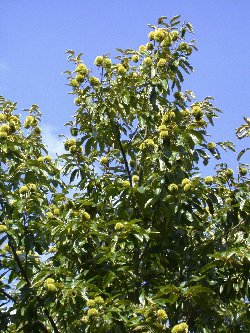
Chinese hybrids (Castanea x mollissima). While most hybrids perform poorly compared to pure Chinese, there are a few notable exceptions. These hybrids offer the potential for higher yields while maintaining excellent Chinese nut qualities. Because hybrids are more variable, some individuals will need to be culled for poor performance. Therefore, hybrids should comprise no more than one third of a commercial planting. These are sold under the category of Chinese chestnuts in our webstore. Below is the current list of Chinese hybrids available as seed or trees.
A5 – This is a tall, “timber-type” tree with an open crown. The open crown growth habit is inherently productive. It is an offspring of ‘Myoka’ and looks to be a European/Chinese hybrid. It ripens mid-season. Nuts are medium size and high quality. It is pollenized by unrelated pure Chinese.
Ace – This is a male-sterile complex hybrid derived from American, Chinese, and European (hence “ACE”). It exhibits marroni-type growth and flowering including heavy crop loads. But, in contrast to marroni, it is cold-hardy, blight resistant, and bears high-quality, easy-peeling nuts. In other words, it combines good the characteristics of European and Chinese chestnuts. Its offspring are vigorous and precocious.
Cirone – This is a 2nd generation European/Chinese hybrid which is a large, vigorous tree that is blight resistant and bears prolific crops of large nuts that peel well and have good flavor.
Luvall’s Monster – This is a male sterile hybrid from IL that is part American and part Japanese or Chinese (conflicting evidence). It is highly productive producing large nuts that are much wider than they are long. It has good flavor, but lots of doubles and poor keeping quality. When pollenized by Chinese chestnuts, the offspring are male sterile and most exhibit better quality, Chinese type nuts.
Hansen – This is an “Etter” hybrid seedling from Norm Hansen in IA. It is a tall, “timber-type” tree with an open, tiered branching structure. It is consistently productive, even after the spring freeze of 2020, but nut size varies with crop load and flavor is bland. It has been absolutely free from gall wasps when its neighbors were heavily infested. It’s blight free, and maintains healthy foliage, being relatively unaffected by potato leafhoppers and other leaf-feeding insects. Its nut characteristics are predominantly Chinese, but its leaves, vigor, and growth habit indicate hybrid ancestry, probably including Japanese, and maybe even American. It is pollenized by unrelated Chinese trees with better nut flavor.
NH Pair – I have 2 sibling seedlings that are grandchildren of ‘Meader’s New Hampshire #4’, which is a Japanese hybrid, probably with American and Chinese, selected in New Hampshire for exceptional cold hardiness. These NH#4 derivatives are tall, timber-type growers with smallish nuts of good Chinese-type quality (better quality than NH#4). They are very reliable and heavy producers, even producing a crop after the spring freeze of 2020. They drop nuts and leaves early, which is an indication of short season (northern) adaptation. They are pollenized by unrelated but good quality Chinese.
Japanese (Castanea crenata). Seedlings from the cultivar collection at the Korean Institute of Forest Genetics have resulted in high quality Japanese-type chestnuts. We collect bulked seed from this planting. These trees are vigorous and productive, but lack the kernel quality of Chinese chestnuts. Limited supply.
Allegheny chinkapin (Castanea pumila). Grown from our own selected population of chinkapins (not chinkapin oaks!) Allegheny chinkapins are native to southeastern USA. Some of our newer chinkapins are hybrids between Allegheny chinkapins and Ozark chinkapins. Chinkapins are a shrub or small tree reaching a mature height of about 25 ft. They produce large quantities of tiny nuts (400-500 per lb.) in clusters of burs. They are great for wildlife or landscape use.
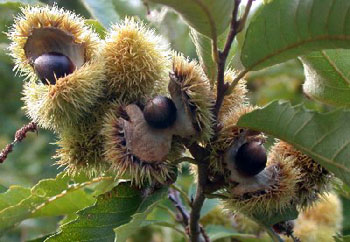
Timber hybrids (Castanea hybrids). Timber hybrid seed/seedlings come from an isolated block of trees that have been assembled over a period of years. The trees in this block are seedlings or grafted trees that meet the following criteria: they are American chestnut hybrids, OR they exhibit a tall, straight growth form combined with adequate blight resistance. Every year, new trees are added to the collection and poorly growing (loss of apical dominance) trees are removed. Blight susceptible trees essentially remove themselves (they don’t produce seeds), but they remain in the planting to provide a constant barrage of blight fungus inoculum to challenge the other trees in the block. The trees come from a diverse background including the following: 1) a local American X Chinese that is unusually blight resistant; 2) Paragon X Chinese; 3) 3rd and 4th generation offspring from Meader’s New Hampshire #4 – mostly Japanese-looking with good stem form and blight resistance; 4) offspring from a Euro-Japanese hybrid selected in Switzerland for blight resistance and growth form. Also included are offspring from the above selections. These trees all pollinate each other so the resulting seeds are a genetic mixture. Most of the seedlings will carry some American chestnut germplasm, but overall the trees are much less than half American; the balance of their heritage is Japanese, European, and/or Chinese. It is likely that a substantial portion of the offspring from this planting will be blight susceptible and/or have poor stem form. But hopefully, some of them will exhibit a forest-competitive combination of blight resistance and height growth. All of them will produce seeds for wildlife commencing at age 3-7 years. These seeds/trees are for experimental purposes and genetic development purposes; they are not yet ready for reforestation purposes.
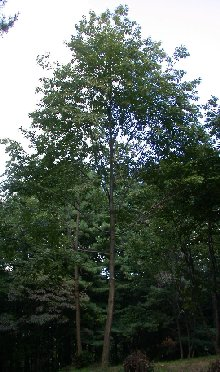
Wildlife hybrids (Castanea hybrids). Wildlife hybrids come from a contiguous block of trees that is composed of C. seguinii X C. dentata hybrids and C. pumila X C. mollissima hybrids. Many of the trees are 2nd or 3rd generation trees from the hybrids listed. They have been selected for blight resistance. They all are prolific bearers of small chestnuts and should commence producing chestnuts at age 3-5 years. The nut size is generally larger than chinkapins, but smaller than Chinese. Ultimate tree size will vary, but they should end up in the 20 ft to 50 ft height range. This is not tall enough to compete in North American forests. The small chestnuts produced will attract birds as well as squirrels, deer, etc. An added bonus is that the chestnuts are very tasty as human food; probably better-tasting than most Chinese chestnuts. Unfortunately, they’re probably too small for impatient humans to shell and eat.
